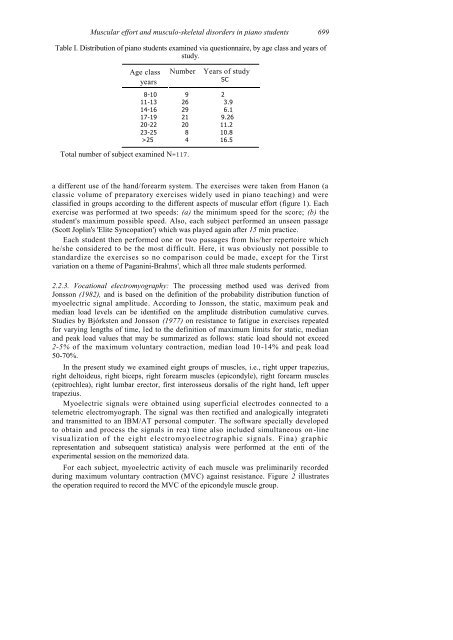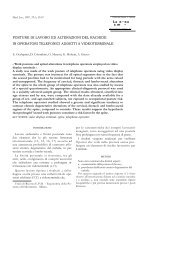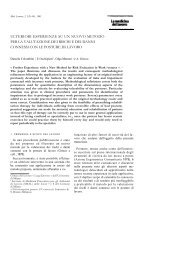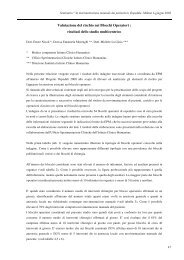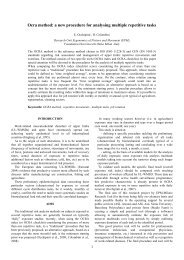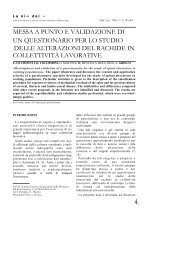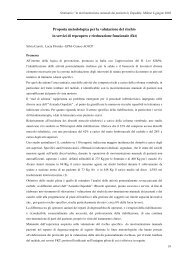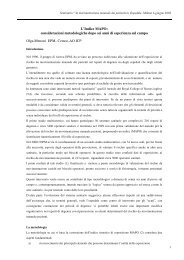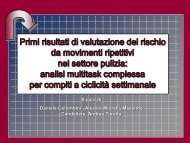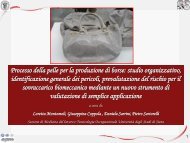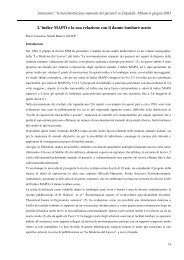Muscular effort and musculo-skeletal disorders in piano students - epm
Muscular effort and musculo-skeletal disorders in piano students - epm
Muscular effort and musculo-skeletal disorders in piano students - epm
You also want an ePaper? Increase the reach of your titles
YUMPU automatically turns print PDFs into web optimized ePapers that Google loves.
<strong>Muscular</strong> <strong>effort</strong> <strong>and</strong> <strong>musculo</strong>-<strong>skeletal</strong> <strong>disorders</strong> <strong>in</strong> <strong>piano</strong> <strong>students</strong> 699Table I. Distribution of <strong>piano</strong> <strong>students</strong> exam<strong>in</strong>ed via questionnaire, by age class <strong>and</strong> years ofstudy.Age classyearsNumberYears of studySC8-10 9 211-13 26 3.914-16 29 6.117-19 21 9.2620-22 20 11.223-25 8 10.8>25 4 16.5Total number of subject exam<strong>in</strong>ed N=117.a different use of the h<strong>and</strong>/forearm system. The exercises were taken from Hanon (aclassic volume of preparatory exercises widely used <strong>in</strong> <strong>piano</strong> teach<strong>in</strong>g) <strong>and</strong> wereclassified <strong>in</strong> groups accord<strong>in</strong>g to the different aspects of muscular <strong>effort</strong> (figure 1). Eachexercise was performed at two speeds: (a) the m<strong>in</strong>imum speed for the score; (b) thestudent's maximum possible speed. Also, each subject performed an unseen passage(Scott Jopl<strong>in</strong>'s 'Elite Syncopation') which was played aga<strong>in</strong> after 15 m<strong>in</strong> practice.Each student then performed one or two passages from his/her repertoire whichhe/she considered to be the most difficult. Here, it was obviously not possible tost<strong>and</strong>ardize the exercises so no comparison could be made, except for the Tirstvariation on a theme of Pagan<strong>in</strong>i-Brahms', which all three male <strong>students</strong> performed.2.2.3. Vocational electromyography: The process<strong>in</strong>g method used was derived fromJonsson (1982), <strong>and</strong> is based on the def<strong>in</strong>ition of the probability distribution function ofmyoelectric signal amplitude. Accord<strong>in</strong>g to Jonsson, the static, maximum peak <strong>and</strong>median load levels can be identified on the amplitude distribution cumulative curves.Studies by Bjórksten <strong>and</strong> Jonsson (1977) on resistance to fatigue <strong>in</strong> exercises repeatedfor vary<strong>in</strong>g lengths of time, led to the def<strong>in</strong>ition of maximum limits for static, median<strong>and</strong> peak load values that may be summarized as follows: static load should not exceed2-5% of the maximum voluntary contraction, median load 10-14% <strong>and</strong> peak load50-70%.In the present study we exam<strong>in</strong>ed eight groups of muscles, i.e., right upper trapezius,right deltoideus, right biceps, right forearm muscles (epicondyle), right forearm muscles(epitrochlea), right lumbar erector, first <strong>in</strong>terosseus dorsalis of the right h<strong>and</strong>, left uppertrapezius.Myoelectric signals were obta<strong>in</strong>ed us<strong>in</strong>g superficial electrodes connected to atelemetric electromyograph. The signal was then rectified <strong>and</strong> analogically <strong>in</strong>tegrateti<strong>and</strong> transmitted to an IBM/AT personal computer. The software specially developedto obta<strong>in</strong> <strong>and</strong> process the signals <strong>in</strong> rea) time also <strong>in</strong>cluded simultaneous on-l<strong>in</strong>evisualization of the eight electromyoelectrographic signals. F<strong>in</strong>a) graphicrepresentation <strong>and</strong> subsequent statistica) analysis were performed at the enti of theexperimental session on the memorized data.For each subject, myoelectric activity of each muscle was prelim<strong>in</strong>arily recordeddur<strong>in</strong>g maximum voluntary contraction (MVC) aga<strong>in</strong>st resistance. Figure 2 illustratesthe operation required to record the MVC of the epicondyle muscle group.


